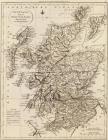1
Dr. John Hutchison, by Arthur Haycock19th Century, Circa 1842
Peterborough, Ontario, Canada
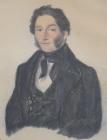 Credits:
Credits:Hutchison House Museum, Peterborough, Ontario, Canada
3
John Hutchison was born outside of the small Scottish town of Kirkcaldy in the county of Fifeshire, on November 27, 1797 to William Hutchison and Elizabeth Fleming. John was the second of seven children including four boys and three girls: William (1796), John (1797), James (1799), Jean (1801), Mary (1802), David (1805) and Elizabeth (1808). Not much is known about the Hutchison family. The father, William, was a baker in Kirkcaldy, and the eldest son, also William, worked in the fisheries. The youngest son, David, would eventually move to Upper Canada like his brother John however not much contact was made between them. Sandford Fleming once commented on David in his diaries: August 14, 1845 "He pointed out David, Dr Hutchison's brother, who has not had any correspondence with any of his family for two or three years. He was glad to see us & asked all about his friends. He will not write before them (they are certainly a strange family) We were in his house & saw his wife & a nice family of 6. He is well paid but drinks & his house has that appearance. His body is like his brother Williams & his head betwixt that & Johns."4
Fleming Family Tree including Dr. John Hutchison and Sir Sandford FlemingGeorgian Era, 1714-1830
Scotland
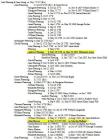 Credits:
Credits:Hutchison House Museum, Peterborough, Ontario, Canada
5
Indenture Agreement for Dr. Hutchison to Dr. Corkindale25 September 1812
Glasgow, Scotland
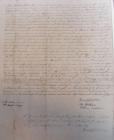 Credits:
Credits:Hutchison House Museum, Peterborough, Ontario, Canada
6
John's decision to become a physician began with the need to find a practicing physician who would accept him as an apprentice. Upon contacting Dr. James Corkindale a legally binding indenture was created and signed by William Hutchison, John Hutchison and James Corkindale on September 25, 1812. The cost to William Hutchison for his son's apprenticeship was twelve Guineas (approximately nine hundred dollars). The indenture agreement bound John as an apprentice to James Corkindale in "his business of surgery and pharmacy" for a duration of three years. Additional stipulations included confidentiality, drug dispensing and absenteeism. Corkindale was responsible for teaching John surgery and pharmacy and was expected to do his best to make John an expert. On May 15th, 1815 James Corkindale discharged John Hutchison as having fulfilled all requirements, certified on the bottom of the indenture.7
Characiture of Dr. James Corkindale (on left) and Dr. Robert Cleghorn (on right)Georgian Era- 1714-1830
Glasgow, Scotland
 Credits:
Credits:Sp Coll Mu Add. q17, Glasgow University Library, Special Collections
8
Dr. James Corkindale was one of the first doctors to practice forensics and was known as the authority in his field. Corkindale's testimony would bring instant conviction or exoneration in court cases. Corkindale was considered eccentric but brilliant in his methods and overall contributions to the medical profession.For example, Corkindale's unorthodox treatments played a vital role in the 1821 case of John McDougall in which the sanity of the accused was disputed. The standard test of insanity was to hold a candle very close to the subject's eyes. If the person winced it was because he had a normal response and was therefore sane. McDougall had four physicians claiming his insanity, while four physicians for the prosecution claimed his sanity based on the standard test.
During the trial, Corkindale had an epiphany while observing children riding a merry-go-round at the local fair. He ordered the ride to be taken inside the jail and McDougall strapped to it so that he could not move. Upon starting the ride McDougall begged to be released because it was making him sick. When the ride stopped, Corkindale took his pulse and declared that the response that McDougall had given was that of person with rational capabilities. This ruling sealed the fate of McDougall and it was unanimously decided by all physicians from this test that the prisoner was sane.
9
Notice for Dr. James Corkindale30 December 1842
Scotland
 Credits:
Credits:MacKenzie, Peter. Old reminiscences of Glasgow and the west of Scotland, Volume 1. James P. Forrester,1890
10
Etching of Glasgow University17th Century, Circa 1650
Glasgow, Scotland
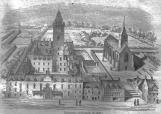 Credits:
Credits:Howie, J. The Scots Worthies (Blackie & Son , 1864)
11
While Indentured under the tutelage of James Corkindale, John Hutchison attended classes at the University of Glasgow. The school, which had been founded in 1451 by Glasgow Cathedral, began teaching modern medicine in 1751. Hutchison attended the university from 1812-1815.A favourite professor at the times was Dr. John Burns, whose lectures on midwifery were popular with the students. The lectures were practical and included anecdotes and humour. In 1799 Dr. Burns began publishing literary works to be used by professionals around the globe. Dr. Burns' final lecture on midwifery was concluded in 1815.
In 1815 Hutchison took a compulsory chemistry course with Dr. Thomas Hope.
Hope is remembered as one of the most popular chemistry professors in Britain. Hope's courses were so popular that attendance almost doubled each successive year he taught chemistry. Students from abroad would come to Edinburgh to attend his lectures and the tardy willingly stood throughout the lectures.
12
Dr. Hutchison's student card19th Century, Circa 1813-14
Glasgow, Scotland
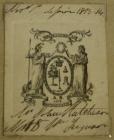 Credits:
Credits:Hutchison House Museum, Peterborough, Ontario, Canada
13
Dr. Hutchison's student card19th Century, Circa 1814-15
Glasgow, Scotland
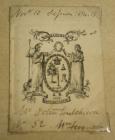 Credits:
Credits:Hutchison House Museum, Peterborough, Ontario, Canada
14
Dr. Hutchison's Library Card for the University of Glasgow16 April 1812
Glasgow, Scotland
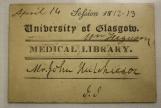 Credits:
Credits:Hutchison House Museum, Peterborough, Ontario, Canada
